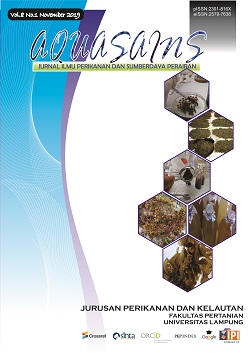UNTILIZATION OF Moringa oleifera LEAF EXTRACT ON DECREASING INFESTATION OF Argulus japonicus IN GOLDFISH (Carassius auratus)
DOI:
https://doi.org/10.23960/aqs.v8i1.p769-774 Abstract View: 680
Abstract View: 680
Abstract
Abstrak Goldfish (Carassius auratus) is one of the fishes that can be infected by parasites. Commonly, this fish is often attacked by Argulus japonicus ectoparasites. Control of infestation in A. japonicus can be done by utilizing one of the natural ingredients, Moringa oleifera leaf extract, which contains of alkaloids, tannins, saponins and flavonoids. This study aims to determine the effect of M. oleifera leaf extract in reducing the infestation of A. japonicus and the optimal concentration of M. oleifera leaf extract in reducing the infestation of A. japonicus in goldfish (C. auratus). This study used a completely randomized design (CRD) with treatments namely control, 600 ppm, 700 ppm, 800 ppm and 900 ppm with four times of replication. The main parameter is the percentage decrease in infestation of A. japonicus. The results of the research data were analyzed by using ANOVA and followed with the Ducan Multiple Range Test. The results showed that Moringa leaf extract could reduce the infestation of A. japonicus. The optimal concentration of Moringa leaf extract in reducing the infestation of A. japonicus was obtained from a concentration of 700 ppm.Downloads
Download data is not yet available.
Downloads
Published
2019-11-26
How to Cite
Setyawati, F., Kismiyati, K., & Subekti, S. (2019). UNTILIZATION OF Moringa oleifera LEAF EXTRACT ON DECREASING INFESTATION OF Argulus japonicus IN GOLDFISH (Carassius auratus). Aqusains: Jurnal Ilmu Perikanan Dan Sumberdaya Perairan, 8(1), 769–774. https://doi.org/10.23960/aqs.v8i1.p769-774
Issue
Section
Articles

.png)










